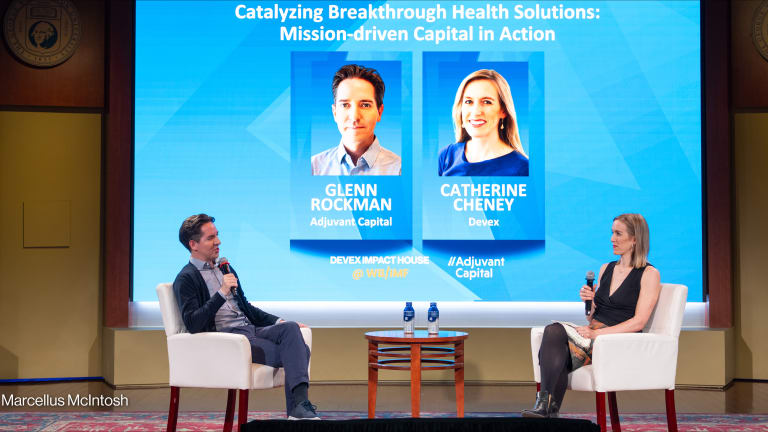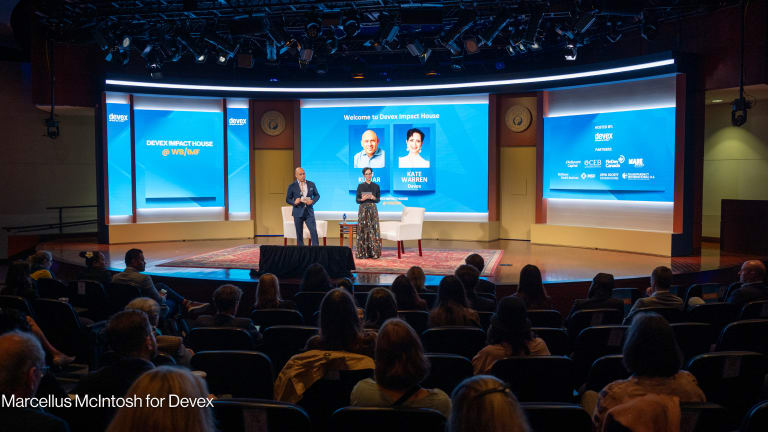SAN FRANCISCO — For social enterprises to realize their potential as influential actors in the global development landscape, they need to scale their impact. That means finding the right capital, from the right sources, at the right time.
On Thursday, Devex hosted a webinar, in collaboration with the Skoll Foundation, to discuss how social enterprises — both for-profit and nonprofit — can develop a sustainable funding strategy.
Here are some of the key takeaways from panelists on ways social entrepreneurs can finance their pathways to scale.
Even if you’re a nonprofit, operate like a business
One Acre Fund, a nonprofit social enterprise that supplies smallholder farmers with tools and financing to increase their incomes and improve their livelihoods, applies for grant funding to subsidize activities such as training that are not likely to generate revenue, and debt capital to finance products that people will pay for, such as seeds and fertilizer and solar lamps.
“We are a nonprofit, but we operate a lot like a business,” said Andrew Youn, co-founder and executive director of One Acre Fund. “That combination is really important.”
Grant financing is critical for the organization because it makes it possible to focus on “some of the most deeply unprofitable customers in the world,” and at the same time, revenue is important for providing better services to farmers, he explained.
“What we can do is try and create an incredibly cost effective way of serving the rural poor, and so we’re constantly seeking to drive down our donor cost to serve,” he added.
Whether you’re a nonprofit or a for-profit, consider what role philanthropy can and should play
Adam Grunewald, the co-founder and CEO of Lynk, a technology platform for informal sector workers in Kenya and beyond, shared some of the reasons he set his company up as a for-profit.
“We were concerned that as a nonprofit, we would place substantial restrictions on what would be in or out of bounds in terms of our focus,” he said.
Still, Grunewald talked about a few areas where commercial capital falls short, and where grants can be effective. His call to action was for social entrepreneurs to clearly differentiate their core focus versus their peripheral activities, and assign impact and financial metrics for each.
How grants can help for-profits and nonprofits alike fund pathways to scale
Increasingly, for-profit social enterprises that seek to serve some of the hardest-to-reach populations are looking to grant funding, not just commercial capital, to finance their paths to scale.
Grunewald outlined three grant funding principles that Lynk follows: differentiating whether a grant supports core growth or new initiatives; clearly understanding the funder objectives and expected outcomes, rather than being distracted by dollar signs; and being honest about the capacity of the company to deliver.
Be realistic that the money you raise might determine the people you serve
Social enterprises that serve the poorest of the poor need to acknowledge the reality that they might not be able to reach fully operational self-sustainability, said Alexis Bonnell, head of applied innovation at the U.S. Agency for International Development.
“If you’re really trying to help people that are most disadvantaged, then you have to go in with the intentionality that money from development, aid organizations, philanthropy, et cetera, is probably appropriate,” she said.
Social entrepreneurs who focus on venture capital, equity, and other forms of financing from investors seeking returns have to realize that the decision to take that money will likely drive an organization’s services up-market — meaning they could end up serving less disadvantaged populations, Bonnell said.
She suggested identifying and defining a metric for sustainability or value of impact per dollar, and helping funders understand that. Bonnell pointed to “philanthropic investment per pair,” a metric used by the social enterprise VisionSpring, as one example.
Think of your capital needs as part of a continuum
Whether social entrepreneurs set up a for-profit or nonprofit organization, the question is not only what type of capital they will need, but also when and why, Bonnell said.
She says USAID wants to know how social entrepreneurs see their continuum of capital.
Scaling is not linear, she said, and while some social entrepreneurs may be guilty of seeing any money as good money, what works best is when they have a strategy and intentionality about the type of money they want, from whom, and for what purpose.
“This path to profitability is long, and we understand there are a number of obstacles and opportunities along the way, which is why we look for blended funding,” Grunewald said.
One webinar participant talked about feeling like he fell outside two buckets of funding: venture capitalists who seek exits in three to five years, and foundations making donations. Grunewald and Youn explained that the key is to identify patient capital, and tap into the wider pool of funders between those two extremes — for example, impact investors.
USAID has tried to do more to support social entrepreneurs, Bonnell said, adding that she sees a trend of other donors and NGOs that recognize this as smart business doing the same.
To catch more of the conversation, you can watch the full webinar here and access the slides here.








